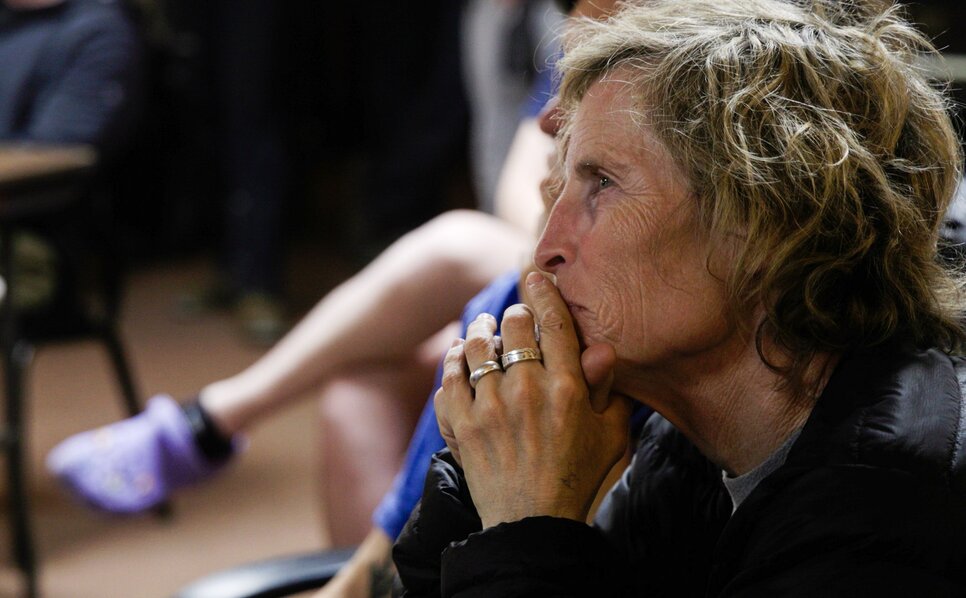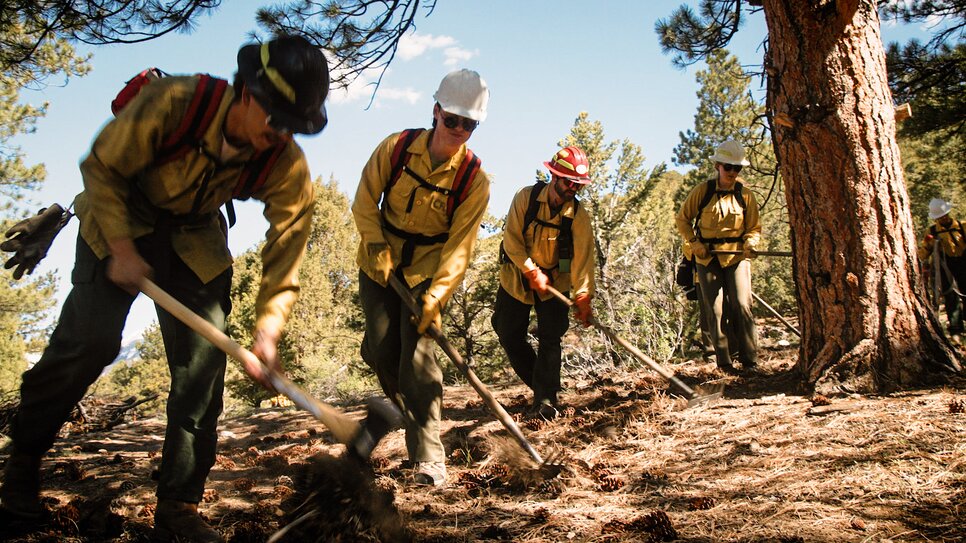Trial by fire: A new generation of wildland firefighters learns the ropes
share

SALIDA, Colo. — Nathan Prater walked across the stage at his high school graduation at 7 p.m. on May 14. He went home, packed his belongings and said goodbye to his family. Early the next morning, Prater left to learn how to fight fire.
Prater was one of 24 students to complete the four-day S-130/S-190 wildland firefighter training at the Colorado Fire Camp last month. Prater, 17, is already a certified EMT. He hopes that adding wildland firefighter training will bolster his resume and open jobs as a paramedic.
Prater shields his eyes with a pair of Pit Viper sunglasses, a graduation present. He’s a self proclaimed adrenaline junkie.
Beneath this cavalier veneer, however, Prater carries a sense of maturity he developed from treating people in life-threatening situations as an EMT.
“It’s all fun and games until someone’s life is on the line. It just feels different,” said Prater. Everything else fades away. “My life, tests, finals, family. This person is in pain. I need to help them.”
Every year, roughly 800 students from around the U.S. and beyond attend classes at the Colorado Fire Camp. Students must be 17 by the time they attend training and 18 to work as firefighters. Once students complete the four-day S-130/S-190 course and pass a physical fitness test — which requires walking three miles in under 45 minutes while carrying a 45 pound pack — they are eligible to work on live fire.
In addition to basic firefighter training, the Colorado Fire Camp also teaches courses to train wildland sawyers, crew bosses and medics.
“We just had a student from Germany,” said Kent Maxwell, who founded the camp in 2002.
That was a particularly bad year for fire in Colorado. In 2002, the Hayman, Missionary Ridge and Iron Mountain fires burned more than 215,000 acres and destroyed 291 houses.
Maxwell — who has served as a volunteer firefighter with Chaffee County for 34 years — saw an opportunity to turn his parents' aging ski lodge into a place to train firefighters. The lodge, which lies at the base of Mount Shavano, 12 miles west of Salida, provides ample hills for practice exercises and terrain similar to what firefighters might encounter on the job.
To this day, the camp aims “to protect life, preserve communities, and conserve America’s wildland resources by training students for suppression of wildfire, mitigation of wildfire risk, and stewardship of forests and grasslands.”
According to Maxwell, the camp is the only year-round wildland firefighter school in the country. Most wildland firefighters complete their basic ‘redcard’ training after obtaining sponsorship from a local fire department or federal agency, such as the U.S. Forest Service (USFS), Bureau of Land Management (BLM) or National Park Service (NPS).
But as fires become more prevalent and intense — due to climate change, drought, and a legacy of total fire suppression — there is more demand for full time and seasonal firefighters, especially those who already meet minimum requirements to work on a fire. Other schools that offer the S-130 and S-190 courses include the Colorado Wildland Fire and Incident Management Academy and Northwest Community College.
“It used to be maybe two thirds of the Forest Service workforce was non-fire and a third was fire. And now it's almost flip flopped. It's almost two thirds that are firefighters,” he said.
Although other federal agencies, including the BLM and the U.S.Fish and Wildlife Service also hire wildland firefighters, the USFS employs the majority of federal firefighters (11,300 out of 18,700 firefighters nationally). In addition to providing training for federal wildland firefighters, Maxwell has seen an increase in people from local parks and recreation organizations who seek training.
As Colorado battens down the hatches for another fire season, many fire crews are struggling to recruit or retain firefighters. As of May, the U.S. Forest Service is reporting a gap in its workforce. According to the Government Accountability Office (GAO), the biggest challenges to retaining firefighters include low pay, poor work-life balance, a lack of career advancement and mental health challenges.
In 2021, the Biden Administration temporarily raised the minimum wage for wildland firefighters from $13 to $15 an hour. But these changes remain temporary solutions. Many firefighters must work long hours to earn overtime pay, travel to find work and face unemployment when the season ends.

Despite these hurdles, many of the students said they feel a magnetic attraction to the work.
“It’s not about the money, It’s about the experience,” said Jalen Armstrong, 18, who graduated high school alongside Prater. He plans to attend Metro State University in the fall and fight fires during his summer breaks.
“It’s about getting out there and traveling the country and embracing the suck and being better than you think you could be,” Armstrong said.
“It’s kind of a modern day cowboy,” said Maxwell, describing the job.
Lisa Coleman, 58, was the oldest student and one of several women in the course. Coleman gained some experience with fire working as a backcountry ranger in Yellowstone. After raising two kids, she wants to chase her passions again.
“I called here and I said, ‘Am I too old?’ and Kat [an instructor] said, ‘no way, you’re not too old,’ and so here I am,” said Coleman.
“When you’re doing this work you have to be in somewhat good shape. And, I’m not the new generation coming in, so that is a little bit of a challenge. But as we get older, we get smarter, too,” she said with a grin.

The course emphasizes teamwork, risk management and communication.
On the last day, the instructors canceled a live fire exercise due to high winds in the area. Instead, they divided the students into four groups. The goal was to pump water from a creek that runs through the camp, up a 500 foot hill to a site the students aimed to defend from incoming flames. Half of the students worked to set up a pump at the creek and lay a hose line, while the other students prepared attack lines at the top of the hill.
“This is one of those things that you let the students figure it out, do some troubleshooting and make some mistakes. It’s easy for us to want to push, but it’s better to let them troubleshoot this and figure it out,” said Kat Pedersen, one of the instructors and training coordinator.
At one point, the lower pump died, cutting off the water supply to the upper groups. After the exercise, the students convened to review how it went.
“Do you wish you asked more questions before we started?” asked Pedersen. A resounding “yes” echoed from the circle of students.

A member from the lower crew complained about poor radio communication. Others
agreed that their communication needed work.
Because weather and fire conditions can change rapidly, communication is often
a factor in firefighter deaths.
“We can send people to Mars, but we can’t talk to each other on a fire,” said
Pedersen.
Risk management is central to the training Colorado Fire Camp provides.
Maxwell said that many of the students who attend are young men, who may lack
judgment or experience managing risks beyond the individual level.
“We’re trying to get them to make wise collective choices because wildland
fire is a team sport,” said Maxwell.
On the last night of the four day class, students gathered into a large
classroom to watch a video about the Point Fire in Kuna, Idaho, which claimed
the lives of two firefighters in 1995.
After the somber video, Pedersen led a discussion about what went wrong and
how the students can avoid the same fatal mistakes.
“What do you want to give up? You want to give up your life for a tree?” she
asked.
Pedersen has seen the fire industry and education evolve since she took basic
fire training more than 30 years ago. She said that young firefighters were
once expected to shut up and follow orders.
Now, wildland firefighters receive training on how to properly refuse an order
when they deem it unsafe.
Despite meeting each other just four days prior, there is a unique sense of
camaraderie among the students. They prod one another. The instructors tell
war stories, like the time a fire crew drank the entire bowling alley dry on a
night off. It’s a feeling that foreshadows life on the fire line.
“What I love is that it’s all about teamwork,” said Coleman. “I grew up
playing sports, and it was all team oriented, and, so I feel like I’m just
circling back to being a kid again.
Cormac McCrimmon is a multimedia journalist at Rocky Mountain PBS.
Cormacmcrimmon@rmpbs.org